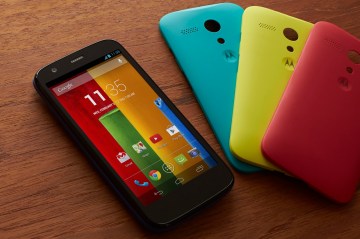Barring any unforeseen circumstances, I recently decided that my next phone would come from Motorola. My time with a Moto X review unit was wonderful, and I’d hoped the timing of a successor would match up with the end of my current wireless contract.
Lenovo’s plan to acquire Motorola from Google–minus the patents and Motorola’s advanced technology division–could be that unforeseen circumstance. Google had spent the last year and a half rebuilding Motorola by decimating its dumbphone business, paring down its product lineup and encouraging clever software over useless gimmicks. Although Motorola was losing money, CEO Dennis Woodside had talked about Google’s long-term commitment to turning things around, and it seemed like Motorola was on the right track.
Now I’m worried all that work will hit a dead-end, and that Lenovo will steer Motorola in a different direction. In terms of product strategy, the two companies couldn’t be any less in-tune.
While Motorola has taken the “less is more” approach to smartphone hardware, Lenovo throws pasta at the wall. Since last fall, Lenovo has announced or released nine Android phones, compared to just five for Motorola. And if you don’t count the trio of Droids that Motorola produced exclusively for Verizon, Motorola only has two phones in its lineup right now, the Moto X and the Moto G. For more evidence of Lenovo’s “try anything” approach, just look at how many Windows 8 hybrid designs Lenovo has put out over the last year and half, seemingly unable to decide what works best. While Lenovo’s willingness to experiment has resulted in some great products, it has also produced a fair amount of junk. I’d hate for Motorola to lose its focus when Lenovo takes over.

Under Google, Motorola has shown similar restraint with software. Instead of dragging down Android with cheap gimmicks, Motorola added useful features such as touchless voice control and a low-power view for notifications. And instead of adding change for change’s sake–as Samsung, HTC and LG so often do–Motorola left the best-looking parts of Android alone. Spend enough time with the Moto X, and you’ll come to appreciate the attention to detail, something that’s sorely missing from so many other Android phones. Motorola also made a concerted effort to update its latest phones quickly, with the Moto X and Moto G receiving Android 4.4 long before any other non-stock Android phone.
Lenovo’s Android devices are on the opposite end of the spectrum. The recent Yoga tablets are a disaster on the software front, ripping off the look of iOS but neglecting to steal the simplicity that makes Apple‘s software work. It’s the worst of both worlds. Lenovo’s earlier Android skin, which forced an ugly tile menu onto its users, was no better.
Maybe I’m being too pessimistic. Maybe Motorola’s transformation under Google is precisely why Lenovo was interested, and Motorola will get to apply what it’s learned for years to come. That would be the best-case scenario.
The worst case scenario would be the return of bloatware and more made-to-order phones for wireless carriers. In pursuit of short-term profits, Lenovo would use Motorola’s brand and carrier partnerships as an entry point into the U.S. market, but wouldn’t bother to preserve Motorola’s newfound talent.
I’ll concede that my hopes and fears for Motorola have little to do with the business side. Motorola was losing money after all, so it’s possible that the current strategy of producing fewer, better phones just wasn’t working. But I’d like to think the strategy just needs more time to grow. Here’s hoping Lenovo has more patience than Google did.

